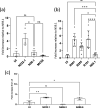Variable disruption of epithelial monolayers by Neisseria meningitidis carriage isolates of the hypervirulent MenW cc11 and MenY cc23 lineages
- PMID: 36821361
- PMCID: PMC10197870
- DOI: 10.1099/mic.0.001305
Variable disruption of epithelial monolayers by Neisseria meningitidis carriage isolates of the hypervirulent MenW cc11 and MenY cc23 lineages
Abstract
Colonization of mucosal tissues by Neisseria meningitidis requires adhesion mediated by the type IV pilus and multiple outer-membrane proteins. Penetration of the mucosa and invasion of epithelial cells are thought to contribute to host persistence and invasive disease. Using Calu-3 cell monolayers grown at an air-liquid interface, we examined adhesion, invasion and monolayer disruption by carriage isolates of two clonal complexes of N. meningitidis. Carriage isolates of both the serogroup Y cc23 and the hypervirulent serogroup W cc11 lineages exhibited high levels of cellular adhesion, and a variable disruption phenotype across independent isolates. Inactivation of the gene encoding the main pilus sub-unit in multiple cc11 isolates abrogated both adhesive capacity and ability to disrupt epithelial monolayers. Contrastingly, inactivation of the phase-variable opa or nadA genes reduced adhesion and invasion, but not disruption of monolayer integrity. Adherence of tissue-disruptive meningococci correlated with loss of staining for the tight junction protein, occludin. Intriguingly, in a pilus-negative strain background, we observed compensatory ON switching of opa genes, which facilitated continued adhesion. We conclude that disruption of epithelial monolayers occurs in multiple meningococcal lineages but can vary during carriage and is intimately linked to pilus-mediated adhesion.
Keywords: MenW; Neisseria meningitidis; air–liquid interface; meningococcus; opa; phase variation.
Conflict of interest statement
The authors declare that there are no conflicts of interest.
Figures







References
Publication types
MeSH terms
Grants and funding
LinkOut - more resources
Full Text Sources
Medical
Miscellaneous

